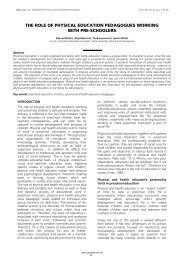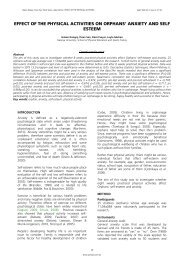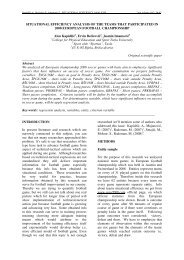The differences in some anthropometric characteristics between top ...
The differences in some anthropometric characteristics between top ...
The differences in some anthropometric characteristics between top ...
You also want an ePaper? Increase the reach of your titles
YUMPU automatically turns print PDFs into web optimized ePapers that Google loves.
Popović S., Molnar S., Mašanović B.: THE DIFERENCES IN SOME... Vol. 6 Issue 1&2: 14-19<br />
MAXCAD 5.437 .023 -1.198 47.1 .237 -.87 .73 -2.33 .59<br />
TRSKTH 22.887 .000 -5.164 37.04 .000* -3.302 .64 -4.598 -2.007<br />
FASKTH 21.311 .000 -4.555 31.161 .000* -2.932 .644 -4.245 -1.619<br />
THSKTH 15.546 .000 -6.759 37.103 .000* -7.696 1.139 -10.003 -5.389<br />
CASKTH 14.757 .000 -5.116 37.755 .000* -4.164 .814 -5.813 -2.516<br />
CHSKTH 68.877 .000 -7.71 31.465 .000* -10.078 1.307 -12.742 -7.414<br />
ABSKTH 37.152 .000 -6.096 31.004 .000* -9.004 1.477 -12.017 -5.992<br />
Exam<strong>in</strong><strong>in</strong>g the first table it is possible to spot the<br />
<strong>differences</strong> <strong>in</strong> central and dispersion parameters<br />
<strong>between</strong> the footballers and the respondents who<br />
play sports recreationally with respect to the<br />
accumulation of subcutaneous adipose tissue,<br />
while <strong>in</strong> the case of parameters regard<strong>in</strong>g<br />
longitud<strong>in</strong>al and transversal dimensionality of<br />
the skeleton, the body mass and body volume<br />
these <strong>differences</strong> are not prom<strong>in</strong>ent as <strong>in</strong> the<br />
case of the parameters used for assess<strong>in</strong>g<br />
subcutaneous adipose tissue. Based on the<br />
observed results it is obvious that the footballers<br />
manifest higher values regard<strong>in</strong>g an elbow<br />
diameter and wrist diameter, as well as <strong>in</strong> the<br />
case of a m<strong>in</strong>imal thigh circumference and<br />
m<strong>in</strong>imal calf circumference. On the other hand,<br />
the respondents who play sports recreationally<br />
manifest higher values <strong>in</strong> the case of body<br />
height, body mass, knee diameter, ankle<br />
diameter, m<strong>in</strong>imal and maximum upper arm<br />
circumference, m<strong>in</strong>imal and maximum forearm<br />
circumference and maximum calf<br />
circumference.<br />
<strong>The</strong> discrim<strong>in</strong>ative analysis procedure enabled<br />
determ<strong>in</strong><strong>in</strong>g significant <strong>differences</strong> <strong>between</strong> the<br />
footballers and the respondents play<strong>in</strong>g sports<br />
recreationally (table 2). Based on the obta<strong>in</strong>ed<br />
results it was determ<strong>in</strong>ed that the results of the<br />
subsamples differ to a considerable extent with<br />
respect to twelve <strong>anthropometric</strong> <strong>characteristics</strong><br />
(body mass, m<strong>in</strong>imal and maximum upper arm<br />
circumference, maximum forearm<br />
circumference, maximum thigh circumference,<br />
m<strong>in</strong>imum calf circumference, triceps sk<strong>in</strong>fold<br />
thickness, forearm sk<strong>in</strong>fold thickness, thigh<br />
sk<strong>in</strong>fold thickness, calf sk<strong>in</strong>fold thickness, chest<br />
sk<strong>in</strong>fold thickness and abdom<strong>in</strong>al sk<strong>in</strong>fold<br />
thickness).<br />
By means of a discrim<strong>in</strong>ative analysis it was<br />
determ<strong>in</strong>ed that <strong>anthropometric</strong> <strong>characteristics</strong><br />
were more <strong>in</strong> favor of a group of respondent<br />
who actively played football <strong>in</strong> most cases,<br />
especially when it was the case of the<br />
parameters for assess<strong>in</strong>g subcutaneous adipose<br />
tissue, also confirmed <strong>in</strong> <strong>some</strong> earlier researches<br />
(Bala, 1981; Sekereš, 1985; Siozios, 1985;<br />
Molnar, 1998; Molnar, Radosav and Smajić,<br />
1999). Furthermore, it was also observed that<br />
sk<strong>in</strong>folds are considerably thicker <strong>in</strong> the<br />
respondents who played sports recreationally,<br />
and the difference was 3.302 mm <strong>in</strong> the case of<br />
upper arm sk<strong>in</strong>fold thickness and 2.932 mm <strong>in</strong><br />
the case of forearm sk<strong>in</strong>fold thickness, 7.696<br />
mm with respect to thigh sk<strong>in</strong>fold thickness,<br />
4.164 mm with respect to calf sk<strong>in</strong>fold<br />
thickness, 10.078 mm with respect to chest<br />
sk<strong>in</strong>fold thickness, 9.004 mm with respect to<br />
abdom<strong>in</strong>al sk<strong>in</strong>fold thickness, which confirms<br />
the fact that physical education has a positive<br />
effect on the reduction of subcutaneous adipose<br />
tissue. Moreover, <strong>in</strong> <strong>some</strong> earlier researches<br />
carried out <strong>in</strong> different time period certa<strong>in</strong><br />
<strong>differences</strong> were observed with respect to<br />
subcutaneous adipose tissue both <strong>in</strong> the<br />
respondents who played sports actively and<br />
those who played sports recreationally (Sekereš,<br />
1985; Siozios, 1985; Molnar, 1998). <strong>The</strong>se<br />
researches also confirmed that the older the<br />
respondents are, the bigger the difference, and<br />
therefore the difference with respect to<br />
subcutaneous adipose tissue is smaller <strong>in</strong> the<br />
case of younger respondents, and on the other<br />
hand it gets bigger with age (Molnar, 1998). In<br />
addition to this, it was also determ<strong>in</strong>ed that the<br />
respondents who play sports recreationally<br />
manifest considerably higher body mass values<br />
where a difference of 6.8 cm was observed, then<br />
a difference of 2.58 cm <strong>in</strong> the case of a<br />
m<strong>in</strong>imum upper arm circumference and f<strong>in</strong>ally<br />
the identical difference <strong>in</strong> the case of a<br />
maximum upper arm circumference. In the case<br />
of maximum upper arm circumference the<br />
difference is 1.66 cm, while <strong>in</strong> the case of a<br />
maximum thigh circumference the difference<br />
was 3.11 cm <strong>in</strong> favor of the respondents who<br />
play sports recreationally. <strong>The</strong> only<br />
characteristic that was more prom<strong>in</strong>ent <strong>in</strong> the<br />
footballers was the m<strong>in</strong>imum calf circumference<br />
and the difference was 1.16 cm. However, these<br />
<strong>differences</strong> were not observed <strong>in</strong> the previous<br />
researches and it could be considered that<br />
<strong>differences</strong> <strong>in</strong> these <strong>characteristics</strong> <strong>in</strong>dividual <strong>in</strong><br />
character and cannot be uniform for the whole<br />
population.<br />
CONCLUSION





